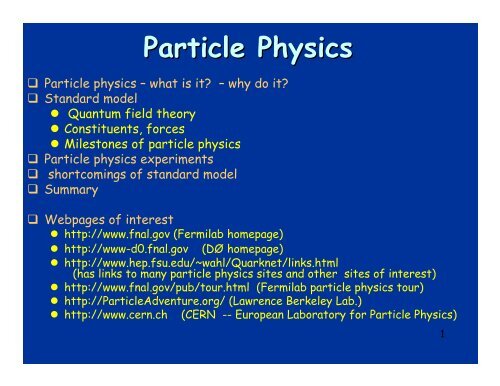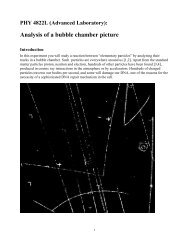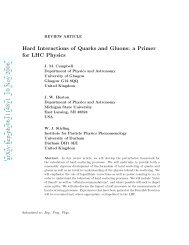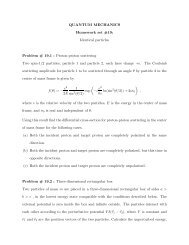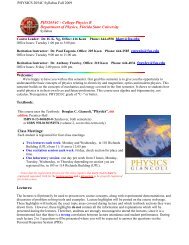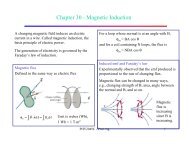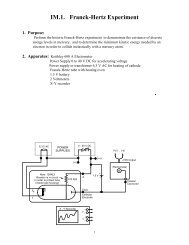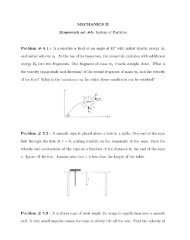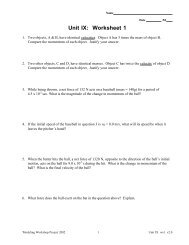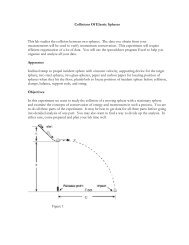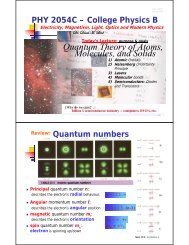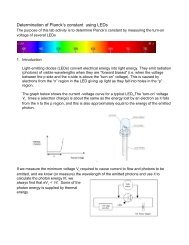Particle Physics - FSU Physics Department
Particle Physics - FSU Physics Department
Particle Physics - FSU Physics Department
Create successful ePaper yourself
Turn your PDF publications into a flip-book with our unique Google optimized e-Paper software.
<strong>Particle</strong> <strong>Physics</strong><br />
<strong>Particle</strong> physics – what is it? – why do it?<br />
Standard model<br />
• Quantum field theory<br />
• Constituents, forces<br />
• Milestones of particle physics<br />
<strong>Particle</strong> physics experiments<br />
shortcomings of standard model<br />
Summary<br />
Webpages of interest<br />
• http://www.fnal.gov (Fermilab homepage)<br />
• http://www-d0.fnal.gov (DØ homepage)<br />
• http://www.hep.fsu.edu/~wahl/Quarknet/links.html<br />
(has links to many particle physics sites and other sites of interest)<br />
• http://www.fnal.gov/pub/tour.html (Fermilab particle physics tour)<br />
• http://<strong>Particle</strong>Adventure.org/ (Lawrence Berkeley Lab.)<br />
• http://www.cern.ch (CERN -- European Laboratory for <strong>Particle</strong> <strong>Physics</strong>)<br />
1
Topics<br />
• what is particle physics, goals and issues<br />
• historical flashback over development of the<br />
field<br />
o cosmic rays<br />
o particle discoveries<br />
o forces<br />
o new theories<br />
• the standard model of particle physics<br />
2
About Units<br />
Energy - electron-volt<br />
• 1 electron-volt = kinetic energy of an electron when<br />
moving through potential difference of 1 Volt;<br />
o 1 eV = 1.6 × 10 -19 Joules = 2.1 × 10 -6 W•s<br />
o 1 kW•hr = 3.6 × 10 6 Joules = 2.25 × 10 25 eV<br />
o 1 MeV = 10 6 eV, 1 GeV = 10 9 eV, 1 TeV = 10 12 eV<br />
mass - eV/c 2<br />
o 1 eV/c 2 = 1.78 × 10 -36 kg<br />
o electron mass = 0.511 MeV/c 2<br />
o proton mass = 938 MeV/c 2 = 0.938 GeV/ c 2<br />
o neutron mass = 939.6 MeV/c 2<br />
momentum - eV/c:<br />
o 1 eV/c = 5.3 × 10 -28 kg m/s<br />
o momentum of baseball at 80 mi/hr ≈ 5.29 kgm/s ≈ 9.9 × 10 27<br />
eV/c<br />
Distance<br />
o 1 femtometer (“Fermi”) = 10 -15 m<br />
3
Outline<br />
what is particle physics?<br />
Origins of particle physics<br />
• Atom (p, e - ), radioactivity, discovery of neutron (n) (1895-<br />
1932)<br />
• Cosmic rays: positron (e + ), muon (μ - ), pion (π), Kaon (K ±, K 0 )<br />
(1932 – 1959)<br />
the advent of accelerators:<br />
• more and more particles discovered, patterns emerge (1960’s<br />
and on):<br />
o leptons and hadrons<br />
o Electromagnetic, weak, strong interactions<br />
present scenario: the Standard Model of electroweak and strong<br />
interactions<br />
• Formulation and discovery (1960’s to 1980’s)<br />
• Precision experimental tests (from 1990’s)<br />
quest for new physics (beyond the standard model)<br />
• Open questions, possible strategies<br />
• Present and future experiments, facilities<br />
• Search for Higgs particle<br />
outlook<br />
4
Sizes and<br />
distance scales<br />
Molecule 10 -9 m<br />
Atom 10 -10 m<br />
nucleus 10 -14 m<br />
virus 10 -7 m<br />
nucleon 10 -15 m<br />
Quark
The Building Blocks of a Dew Drop<br />
A dew drop is made up of 10 21<br />
molecules of water.<br />
Each molecule = one oxygen<br />
atom and two hydrogen atoms<br />
(H 2 O).<br />
Each atom consists of a<br />
nucleus surrounded by<br />
electrons.<br />
Electrons are leptons that<br />
are bound to the nucleus by<br />
photons, which are bosons.<br />
The nucleus of a hydrogen<br />
atom is just a single proton.<br />
Protons consist of three<br />
quarks. In the proton, gluons<br />
hold the quarks together just<br />
as photons hold the electron<br />
to the nucleus in the atom<br />
6
Contemporary<br />
<strong>Physics</strong><br />
Education<br />
7<br />
Project
Goals of particle physics<br />
particle physics or high energy physics<br />
• is looking for the smallest constituents of matter (the<br />
“ultimate building blocks”) and for the fundamental forces<br />
between them (“interactions”);<br />
• aim is to find description in terms of the smallest number of<br />
particles and forces<br />
• Try to describe matter in terms of specific set of<br />
constituents which can be treated as fundamental;<br />
• With deeper probing (at shorter length scale), these<br />
fundamental constituents may turn out to consist of smaller<br />
parts (be “composite”).<br />
• “Smallest constituents” vs time:<br />
o in 19th century, atoms were considered smallest building<br />
blocks,<br />
o early 20th century research: electrons, protons, neutrons;<br />
o now evidence that nucleons have substructure - quarks;<br />
o going down the size ladder: atoms -- nuclei -- nucleons -- quarks<br />
– ???... ??? (preons, toohoos, voohoos,….????)<br />
8
Issues of High Energy <strong>Physics</strong><br />
Issues of High Energy <strong>Physics</strong><br />
Basic questions:<br />
• Are there irreducible building blocks?<br />
o How many?<br />
o What are their properties?<br />
• mass? charge? flavor?<br />
• What is mass?<br />
• What is charge ?<br />
• How do the building blocks interact?<br />
o forces?<br />
o Differences? similarities?<br />
• Why more matter than antimatter?<br />
• why is our universe the way it is?<br />
o Coincidence?<br />
o Theoretical necessity<br />
o Design?<br />
Why do we want to know?<br />
• Curiosity<br />
• Understanding constituents may help in understanding composites<br />
• Implications for origin and destiny of Universe<br />
9
Cosmic rays<br />
• Discovered by Victor Hess (1912)<br />
• Observations on mountains and in balloon: intensity of cosmic<br />
radiation increases with height above surface of Earth – must come<br />
from “outer space”<br />
• Much of cosmic radiation from sun (rather low energy protons)<br />
• Very high energy radiation from outside solar system, but probably<br />
from within galaxy<br />
10
Positron<br />
Positron (anti-electron)<br />
• Predicted by Dirac (1928) -- needed for relativistic<br />
quantum mechanics<br />
• existence of antiparticles doubled the number of<br />
known particles!!!<br />
• Positron track going<br />
upward through lead<br />
plate<br />
o Photographed by Carl<br />
Anderson (Aug. 2, 1932)<br />
o <strong>Particle</strong> moving upward,<br />
as determined by<br />
increase in curvature<br />
of the top half of the<br />
track after it passed<br />
through lead plate,<br />
o and curving to the left,<br />
meaning its charge is<br />
positive<br />
12
Anderson and his cloud chamber<br />
13
Neutron<br />
Bothe + Becker (1930):<br />
• Some light elements (e.g. Be), when bombarded with alpha<br />
particles, emit neutral radiation, “penetrating”– gamma?<br />
Curie-Joliot and Joliot (1932):<br />
• This radiation from Be and B able to eject protons from<br />
material containing hydrogen<br />
Chadwick (1932)<br />
• Doubts interpretation of this radiation as gamma<br />
• Performs new experiments; protons ejected not only from<br />
hydrogen, but also from other light elements;<br />
• measures energy of ejected protons (by measuring their<br />
range),<br />
• results not compatible with assumption that unknown<br />
radiation consists of gamma radiation (contradiction with<br />
energy-momentum conservation), but are compatible with<br />
assumption of neutral particles with mass approximately<br />
equal to that of proton – calls it “neutron”<br />
• Neutron assumed to be “proton and electron in close<br />
association”<br />
14
Chadwick’s s experiment<br />
15
Nuclear force – field quantum<br />
photon carries the electromagnetic force.<br />
Analogy: postulate particle as carrier of nuclear<br />
force (Hideki Yukawa, 1935) with mass intermediate<br />
between the electron and the proton<br />
This particle also to be responsible for beta-decay.<br />
potential energy between the nucleon field quanta<br />
has the form<br />
U<br />
2<br />
g ⎛ R<br />
− exp⎜<br />
−<br />
4π<br />
R ⎝ c<br />
/ mc<br />
=<br />
2<br />
⎞<br />
⎟<br />
⎠<br />
m = mass of the exchanged quantum;<br />
from observed range of nuclear force: mass of the<br />
exchanged particle ≈ 200MeV<br />
16
More particles: Muon<br />
1937: “mesotron” is observed<br />
in cosmic rays (Carl Anderson,<br />
Seth Neddermeyer) – first<br />
mistaken for Yukawa’s particle<br />
However it was shown<br />
in 1941 that mesotrons didn’t<br />
interact strongly with matter.<br />
17
Discovery of pion<br />
in 1947, Lattes, Occhialini and Powell from Bristol<br />
observed decay of a new particle into two particles<br />
one of the decay products is the muon (discovered by<br />
Neddermeyer), and the other is invisible (Pauli's<br />
neutrino).<br />
muon in turn also decays in<br />
18
Kaons<br />
First observation of<br />
Kaons:<br />
• Experiment<br />
by Clifford<br />
Butler and<br />
George<br />
Rochester at<br />
Manchester<br />
• Cloud chamber exposed to cosmic rays<br />
• Left picture: neutral Kaon decay (1946)<br />
• Right picture: charged Kaon decay into muon<br />
and neutrino<br />
• Kaons first called “V” particles<br />
• Called “strange” because they behaved<br />
differently from others<br />
19
“Strange particles”<br />
Kaon: discovered 1946; first called “V” particles<br />
K 0 production and decay<br />
in a bubble chamber<br />
20
Bubble chamber<br />
-<br />
p p<br />
-<br />
→ p n<br />
-<br />
K 0 K - π+ π- π 0<br />
n<br />
-<br />
+ p → 3 pions<br />
π 0 → γγ, γ → e+ e-<br />
K 0 → π+ π-<br />
21
<strong>Particle</strong> Zoo<br />
1940’s to 1960’s :<br />
• Plethora of new particles discovered<br />
(mainly in cosmic rays):<br />
• e-, p, n, ν, μ - , π ± , π 0 , Λ 0 , Σ + , Σ 0 , Ξ,….<br />
question:<br />
• Can nature be so messy?<br />
• are all these particles really intrinsically<br />
different?<br />
• or can we recognize patterns or<br />
symmetries in their nature (charge, mass,<br />
flavor) or the way they behave (decays)?<br />
22
<strong>Particle</strong> spectroscopy era<br />
1950’s – 1960’s: accelerators, better detectors<br />
even more new particles are found, many of them extremely<br />
short-lived (decay after 10 -21 sec)<br />
“particle spectroscopy era”<br />
• Bubble chamber allows detailed study of reactions,<br />
reconstruction of all particles created in the reactions<br />
• find that often observed particles actually originate from<br />
decay of very short-lived particles (“resonances”)<br />
1962: “eightfold way”, “flavor SU(3)” symmetry (Gell-Mann,<br />
Ne’eman)<br />
• allows classification of particles into “multiplets”<br />
• Mass formula relating masses of particles in same multiplet<br />
• Allows prediction of new particle Ω - , with all of its<br />
properties (mass, spin, expected decay modes,..)<br />
• subsequent observation of Ω - with expected properties at<br />
BNL (1964)<br />
23
<strong>Particle</strong> nomenclature<br />
by mass:<br />
• baryons – heavy particles .. p, n, Λ, Σ, Ω - , Δ ++ ….<br />
o nucleons and their excited states: p, n, N * , Δ ++ , ……<br />
o hyperons: Λ, Σ, Ξ, Ω - , and their excited states<br />
• mesons – medium-heavy particles … π, K, K * , ρ, ω …<br />
• leptons – light particles e, μ, ν e , ν μ …<br />
by spin:<br />
• fermions: spin = odd-integer multiple of ½:<br />
½, 3/2, 5/2,……<br />
o leptons and baryons<br />
• bosons: integer spin 0, 1, 2, …. – mesons are bosons<br />
by interaction:<br />
• hadrons: partake in strong interactions<br />
• leptons: no strong interaction<br />
by lifetime:<br />
• stable particles: lifetime > 10 -17 sec<br />
(decay by weak or electromagnetic interaction)<br />
• unstable particles (“resonances”) lifetime
Spin and statistics<br />
Fermions obey “Fermi-Dirac” statistics:<br />
• multi-fermion states are antisymmetric with<br />
respect to exchange of any two identical fermions<br />
(wave function changes sign)<br />
|f 1 , f 2 , f 3 > = - |f 2 , f 1 , f 3 ><br />
• Pauli exclusion principle is special case of this<br />
Bosons obey “Bose-Einstein” statistics:<br />
• multi-boson states are symmetric with respect to<br />
exchange of any two identical fermions (wave<br />
function stays the same)<br />
|b 1 , b 2 , b 3 > = |b 2 , b 1 , b 3 ><br />
• consequence: bosons like to “stick together” (e.g.<br />
Bose-Einstein condensate)<br />
25
Towards the standard model<br />
Quark Model (Gell-Mann, Zweig, 1964)<br />
• observed SU(3) symmetry can be explained by<br />
assuming that all hadrons are made of “quarks”<br />
• There are 3 quarks: u (up), d (down), s (strange);<br />
• quarks have non-integer charge:<br />
o u 2/3, d -1/3, s -1/3<br />
• baryons are made of 3 quarks:<br />
o p = uud, n = udd, Λ = uds, Σ = uus Ξ = uss,<br />
Ω - = sss<br />
• mesons are made of quark-antiquark pairs:<br />
_ _<br />
_ _<br />
o π + = ud, π - = u d, π 0 = u u + d d, ……..<br />
26
The 8-fold 8<br />
way<br />
mesons<br />
qq<br />
K 0<br />
ds<br />
us<br />
K +<br />
π - π 0 ηφ π +<br />
du<br />
ud<br />
uu,dd,ss<br />
Δ -<br />
ddd<br />
baryons qqq<br />
Δ 0<br />
udd<br />
n<br />
uud<br />
p<br />
Δ +<br />
Σ - Σ 0 Λ Σ +<br />
dds<br />
uus<br />
uds<br />
dss<br />
uss<br />
Ξ - Ξ 0<br />
Δ ++<br />
uuu<br />
su<br />
sd<br />
K - K 0<br />
Ω -<br />
sss<br />
27
color charge<br />
problem with quark model<br />
• Quarks have spin ½, i.e. are fermions ⇒ must obey Pauli<br />
principle<br />
• Ω - = sss, has spin 3/2; spins of 3 s quarks must be<br />
aligned, i.e. Ω - has 3 quarks in identical state ---<br />
forbidden<br />
<br />
• similarly for Δ ++ = uuu, spin 3/2<br />
way out: quarks have additional hidden property – “color<br />
charge”<br />
• 3 colors: green, red, blue<br />
• each quark can carry one of three colors<br />
o red blue green<br />
• antiquarks carry anticolor<br />
o anti-red anti-blue anti-green<br />
• observed particles are “color-neutral”;<br />
• only colorless (“white”) combinations of<br />
quarks and antiquarks can form particles:<br />
• qqq<br />
• qq<br />
28
“Elementary” particles?<br />
“leptons” (electron, muon and their<br />
neutrinos) are fundamental, interact<br />
electromagnetically and “weakly”<br />
“hadrons” (p, n, Λ, Σ, Ω - , Δ ++ , π, K, K * ,<br />
ρ, ω,…) are not fundamental particles –<br />
are made of quarks, interact<br />
electromagnetically, “weakly”, and<br />
“strongly”<br />
29
Standard Model<br />
A theoretical model of<br />
interactions of elementary<br />
particles, based on quantum field<br />
theory<br />
Symmetry:<br />
• SU(3) x SU(2) x U(1)<br />
“Matter particles”<br />
• Quarks: up, down,<br />
charm,strange, top, bottom<br />
• Leptons: electron, muon, tau,<br />
neutrinos<br />
“Force particles”<br />
• Gauge Bosons<br />
o<br />
o<br />
o<br />
γ (electromagnetic force)<br />
W ± , Z (weak, electromagnetic)<br />
g gluons (strong force)<br />
Higgs boson<br />
• spontaneous symmetry<br />
breaking of SU(2)<br />
• mass<br />
30
Matter and forces<br />
Fundamental forces (mediated by “force particles”)<br />
• strong interaction between quarks, mediated by gluons<br />
(which themselves feel the force) (QCD)<br />
o leads to all sorts of interesting behavior, like the<br />
existence of hadrons (proton, neutron) and the failure to<br />
find free quarks<br />
• Electroweak interaction between quarks and leptons,<br />
mediated by photons (electromagnetism) and W and Z<br />
bosons (weak force)<br />
Fundamental constituent particles<br />
• Leptons q = quarks q =<br />
-1 e μτ 2/3 u c t<br />
0 ν e ν μ ν τ –1/3 d s b<br />
Role of symmetry:<br />
• Symmetry (invariance under certain transformations)<br />
governs behavior of physical systems:<br />
o Invariance ⇒ “conservation laws” (Noether)<br />
o Invariance under “local gauge transformations”<br />
⇒ interactions (forces)<br />
31
From Contemporary <strong>Physics</strong> Education Project<br />
http://www.cpepweb.org/particles.html<br />
33
From Contemporary <strong>Physics</strong> Education Project<br />
http://www.cpepweb.org/particles.html<br />
34
From Contemporary <strong>Physics</strong> Education Project<br />
http://www.cpepweb.org/particles.html<br />
36
Strong quark interactions<br />
quarks carry “color charge” (red, blue,<br />
green) and interact exchanging gluons,<br />
the carriers of the strong force<br />
theory of strong interaction is “gauge<br />
theory”; form of interaction governed<br />
by invariance under local SU(3) c (“color<br />
SU(3)”)<br />
8 gluons carry color charge ⇒ interact<br />
with each other<br />
37
Electroweak interactions<br />
leptons (and also quarks)<br />
carry a “weak charge”<br />
(in addition to usual<br />
electric charge)<br />
they interact exchanging<br />
• neutral EW force<br />
carriers: photon γ, Z 0<br />
<br />
• charged EW force<br />
carriers: W ±<br />
theory describing EW<br />
interaction is gauge<br />
theory; gauge symmetry<br />
group<br />
SU(2)xU(1)<br />
38
Some milestones<br />
Quantum electrodynamics (QED) (1950’s) (Feynman,<br />
Schwinger, Tomonaga)<br />
electroweak unification – the standard model (1960s)<br />
(Glashow, Weinberg, Salam)<br />
deep inelastic scattering experiments – partons<br />
(SLAC/MIT) (1956 – 1973)<br />
Quark Model (1964) (Gell-Mann, Zweig)<br />
Quantum Chromodynamics (1970s) (Gross, Wilczek,<br />
Politzer)<br />
neutral weak current (1973) (Gargamelle, CERN)<br />
Charm discovery (1974) (S. Ting, B. Richter)<br />
Bottom quark discovery (1977) (L. Lederman)<br />
gluon observation (1979) (DESY)<br />
W,Z observation (1983) (UA1, UA2, C. Rubbia, CERN)<br />
top quark (1995) (DØ, CDF, Fermilab)<br />
39
Brief History of the Standard Model<br />
<br />
<br />
<br />
<br />
<br />
<br />
<br />
<br />
<br />
<br />
<br />
Late 1920’s - early 1930’s: Dirac, Heisenberg, Pauli, & others<br />
extend Maxwell’s theory of EM to include Special Relativity & QM<br />
(QED) - but it only works to lowest order!<br />
1933: Enrico Fermi introduces 1st theory of weak interactions,<br />
analogous to QED, to explain β decay.<br />
1935: Hideki Yukawa predicts the pion as carrier of a new, strong<br />
force to explain recently observed hadronic resonances.<br />
1937: muon is observed in cosmic rays – first mistaken for<br />
Yukawa’s particle<br />
1938: heavy W as mediator of weak interactions? (Klein)<br />
1947: pion is observed in cosmic rays<br />
1949: Dyson, Feynman, Schwinger, and Tomonaga introduce<br />
renormalization into QED - most accurate theory to date!<br />
1954: Yang and Mills develop Gauge Theories<br />
1950’s - early 1960’s: more than 100 hadronic “resonances” have<br />
been observed !<br />
1962 two neutrinos!<br />
1964: Gell-Mann & Zweig propose a scheme whereby resonances<br />
are interpreted as composites of 3 “quarks”. (up, down, strange)<br />
40
Brief History of the Standard Model - 2<br />
<br />
<br />
<br />
<br />
<br />
<br />
1970: Glashow, Iliopoulos, Maiani: 4th quark (charm) explains<br />
suppression of K decay into μμ<br />
1964-1967: spontaneous symmetry breaking (Higgs, Kibble)<br />
1967: Weinberg & Salam propose a unified Gauge Theory of electroweak<br />
interactions, introducing the W ± ,Z as force carriers and the Higgs field<br />
to provide the symmetry breaking mechanism.<br />
1967: deep inelastic scattering shows “Bjorken scaling”<br />
1969: “parton” picture (Feynman, Bjorken)<br />
1971-1972: Gauge theories are renormalizable (even when symmetry is<br />
spontaneoulsy broken) (t’Hooft, Veltman, Lee, Zinn-Justin..)<br />
<br />
1972: high p t<br />
pions observed at the CERN ISR<br />
<br />
<br />
1973: Quantum Chromodynamics (Gross, Wilczek, Politzer, Gell-Mann &<br />
Fritzsch) : quarks are held together by a Gauge-Field whose quanta,<br />
gluons, mediate the strong force<br />
1973: “neutral currents” observed (Gargamelle bubble chamber at CERN)<br />
41
Brief History of the Standard Model - 3<br />
1974: J/Ψ discovered at BNL/SLAC;<br />
1975: J/Ψ interpreted as cc<br />
-<br />
bound state (“charmonium”)<br />
1976: τ lepton discovered at SLAC<br />
-<br />
1977: Υ discovered at Fermilab in 1977, interpreted as bb bound<br />
state (“bottomonium”) ⇒ 3rd generation<br />
-<br />
1979: gluon – jets observed at DESY<br />
-<br />
1982: direct evidence for jets in hadron hadron interactions at<br />
CERN (pp-<br />
collider)<br />
1983: W ± , Z observed at CERN (pp-<br />
collider built for that purpose)<br />
1995: top quark found at Fermilab (DØ, CDF)<br />
1999: indications for “neutrino oscillations” (Super-Kamiokande<br />
experiment)<br />
2000: direct evidence for tau neutrino (ν τ<br />
) at Fermilab (DONUT<br />
experiment)<br />
2005: clear evidence for neutrino oscillations (Kamiokande, SNO)<br />
42
Feynman diagrams<br />
Feynman Diagrams<br />
• In our current understanding, all interactions<br />
arise from the exchange of quanta<br />
• The mathematics describing such interactions<br />
can be represented by a diagram, called a<br />
Feynman diagram<br />
e<br />
e<br />
γ<br />
Feynman<br />
diagram<br />
μ<br />
μ<br />
43
Present scenario<br />
Most of what’s around us is made of very few<br />
particles: electrons, protons, neutrons (e, u, d)<br />
this is because our world lives at very low<br />
energy<br />
all other particles were created at high<br />
energies during very early stages of our<br />
universe<br />
can recreate some of them (albeit for very<br />
short time) in our laboratories (high energy<br />
accelerators and colliders)<br />
this allows us to study their nature, test the<br />
standard model, and discover direct or indirect<br />
signals for new physics<br />
44
Study of high energy interactions -- going back in time<br />
45
Homework set 5<br />
HW 5.1<br />
• go to <strong>Particle</strong> Data Group website:<br />
http://pdg.lbl.gov<br />
• find masses (in MeV or GeV) , principal<br />
decay modes and lifetimes of the<br />
following particles: π ± , π 0 , K 0 , J/Ψ, p, n,<br />
Λ 0 , Σ + , Σ 0 , Ξ, Ω -<br />
• give the quark composition of π ± , π 0 ,<br />
K 0 , J/Ψ, p, n, Λ 0 , Ω -<br />
46
Summary<br />
<br />
<br />
<br />
<br />
<strong>Particle</strong> physics was born during last century, grew out of<br />
atomic and nuclear physics huge progress in understanding<br />
over last 50 years, due to revolutionary ideas in both<br />
theory and experiment<br />
intense dialog between experimenters and theorists<br />
precision tests of standard model ongoing, looking for<br />
hints of new physics<br />
next:<br />
• symmetries<br />
• tests of standard model, experiments, accelerators<br />
• problems and shortcomings of standard model<br />
• new projects, outlook<br />
47


